By Jock Elliott, KB2GOM
When you live in an antenna-challenged situation as I do (stringing long wire antennas outside is problematic for me), the result is a never-ending search for an improved signal.
Toward that end, I’ve experimented with a horizontal room loop, an indoor end-fed, and a short dipole.
Along the way, I decided to test the MFJ 1020C active antenna/preselector, and I liked it pretty well. My conclusion was: Bearing in mind that it won’t improve every signal you want to hear, if you live in an antenna-challenged situation, the MFJ 1020C – particularly if you can get 20-50 feet of wire outdoors or run around the perimeter of a room – may be just what the doctor ordered.
After my test of the 1020C, I had an online conversation with Andrew (grayhat), and he suggested that I might want to have a look at the MFJ 956 passive selector. Its major claim to fame is: “Boost your favorite stations while rejecting images, intermod, and phantom signals! The MFJ-956 Pre-Selector/Antenna Tuner greatly improves reception from .15 to 30 MHz — especially below 2MHz. It has tuner bypass/ground receiver positions. The MFJ-956 measures a compact 2 x 3 x 4 inches.”
MFJ was kind enough to send a 956 to me, and while I did not test it below 2 MHz, I found that it proved very helpful in tuning in the BBC mid-winter broadcast to Antarctica. I started out with the MFJ 1020C. Lots of noise and fades. Reception was somewhat better using the 1020C (compared to bypass), but then I switched to MFJ 956. I found I could copy better with the 956, even though it provides no amplification. Tuning slightly off-peak offered the best copy, better than bypass. I was listening in USB. In all, it is a useful piece of gear.
While poking around the MFJ website I discovered the MFJ 1046 Receiver Preselector, 1.6-33 MHz. Among other claims, MFJ has this to say about the 1046: “MFJs new Passive Preselector has extremely high dynamic range! It improves the performance of nearly any HF or shortwave receiver/transceiver. It vastly improves the most expensive receivers. Especially helpful to those with broadband front-ends that are prone to overload.”
Sounds promising, I thought, so I emailed Thomas, SWLing’s Maximum Leader, to see if maybe MFJ would like me to have a look at one.
A happy accident
A few days later, package arrived.
I was unpacking it when the Brain Dudes interrupted.
Brain Dudes: Hey!!
Me: What?!!
Brain Dudes: That thing look a little weird to you?
Me: Whaddya mean?
Brain Dudes: Look at the front . . . what do you see?
Me: Well, on left, a knob labeled GAIN; next to that, and ON/OFF button; moving to the right, a BAND selector switch, and finally a TUNE knob.
Brain Dudes: And what is the MFJ 1046 supposed to have?
Me: A big tuning knob, an ON/OFF switch, and a BAND selector switch . . . maybe this is an improved model . . .
Brain Dudes: How ‘bout you look on the back panel . . . what do you see?
Me: The usual connections for antenna and receiver . . . and a plug-in socket for an external power supply.
Brain Dudes: Is a passive preselector supposed to have a power socket?
Me: No . . .
Brain Dudes: OK, final clue, Sherlock: suppose you read the label on the front panel.
Me: MFJ 1045C. Holy smokes! They sent me the wrong unit!
(I hear the Brain Dude yelling at someone in the background: “Finally, the light comes on! I told you switching to decaf was a bad idea!)
Brain dudes: So they sent you the wrong unit; suppose you test it anyway since it’s here.
So I did. And it turns out that MFJ sending the 1045C instead of the 1046 was a happy accident because the 1045C, which is an active preselector, delivers excellent performance across the board.
This is what MFJ says about the 1045C: “Lets you copy weak signals. Rejects out-of-band signals, images. 1.8 to 54 MHz. Up to 20 dB gain. Gain control. Dual gate MOSFET, bipolar transistors for low noise, high gain. Connect 2 antennas, 2 receivers. Coax and phone jacks. 9-18 VDC or MFJ-1312D.”
Once the antenna, receiver, and power supply are connected (I used the power supply that MFJ sent me with the 1020C), I operate the 1045C in much the same way as the 1020C:
- With the unit in BYPASS mode (the ON/OFF button out), tune the receiver to the frequency you want to hear.
- Set the GAIN knob to around 3 or 4.
- Set the BAND knob to the band with the MHz that you are tuned to.
- Press the ON/OFF/BYPASS button in. This turns on the active preselector and amplification circuits and a red light comes on to let you know the unit is activated.
- Slowly turn the TUNE knob back & forth. At some point in its tuning range, you will hear the signal and/or noise peak.
- Finally, adjust the GAIN knob for maximum intelligibility of the signal. Sometimes tuning slightly to the side of the peak works best.
I tested the MFJ 1045C with my end-fed indoor antenna (see link above) and with the short dipole (also, see link above). I also did head-to-head comparisons with the MFJ 1020C and those two antennas.
The results
Here’s what I found:
- The indoor end-fed antenna (which is 45 long) out-performs the short dipole (which is 6 feet total length) in all cases. That’s no surprise, but bear in mind that not everyone has a situation in which they can deploy the longer antenna. The 6-foot dipole definitely out-performs the whip antenna on my Satellit 800.
- The 1045C has a broader range of amplification than the 1020C. It appears to reject adjacent channel interference as well or better than the 1020C, and, to my ear, the 1045C has a lower noise floor. If you turn the GAIN knob fully to the left, it gets to a position where it appears to actually attenuate the signal. And I never found a situation in which, if properly tuned, the signal delivered by the 1045C was at least equal to the bypass signal, and many times it was significantly better. In short, in the HF range the 1045C appears do to everything that the 1020C does (with the exception of the 1020C’s screw-in whip antenna) and do it better.
- When using the 1045C with a portable (my Tecsun 880), I found that I could hear the noise peaks better than with the 1020C, which is a great help in tuning for best performance.
So why would you chose the 1020C or the 956 over the 1045C? Short answer: if you are a MW or LW enthusiast. According to MFJ, the 1045C covers 1.8 to 54 MHz; the 1020C covers .3 to 40 MHz, and the 956 covers 150 kHz to 35 MHz.
However, if you are an HF weenie like I am who enjoys teasing out faint signals, and particularly if you are faced with a sub-optimal antenna situation, the MFJ 1045C, in my opinion, is definitely worth a try.
Click here to check out the MFJ-1045C.
Shameless plug: check out the SWLing Post Message Board there are often interesting discussions going on there.

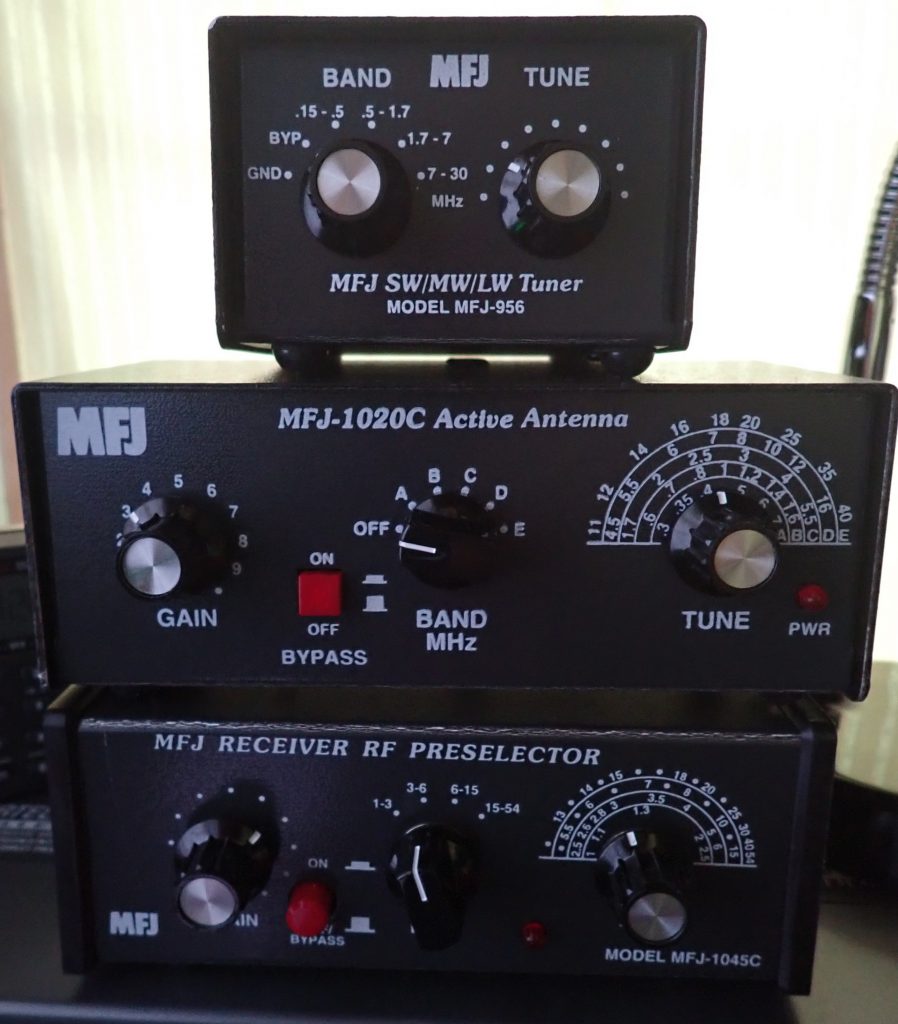
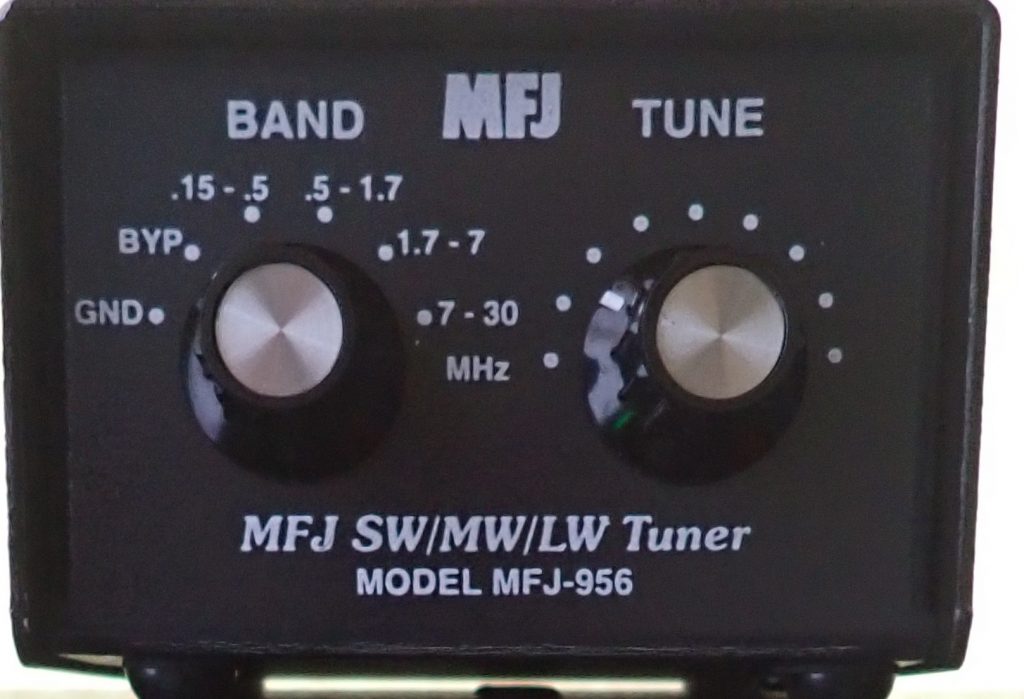
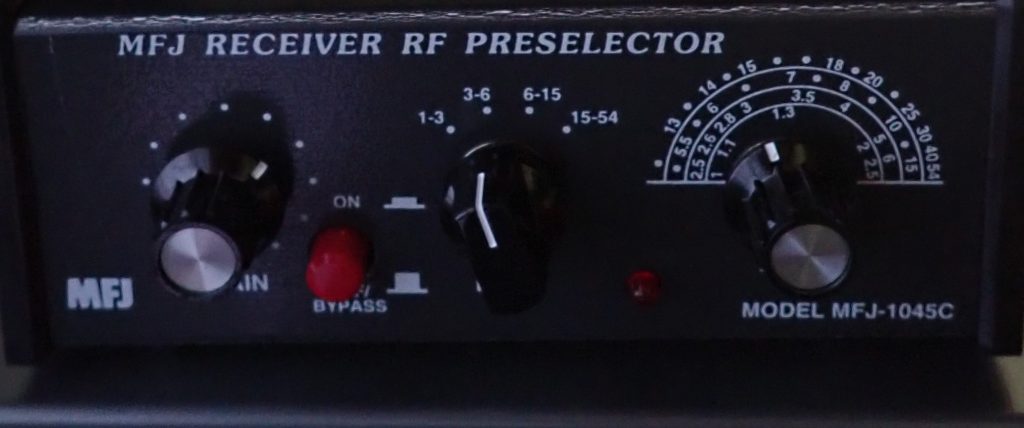
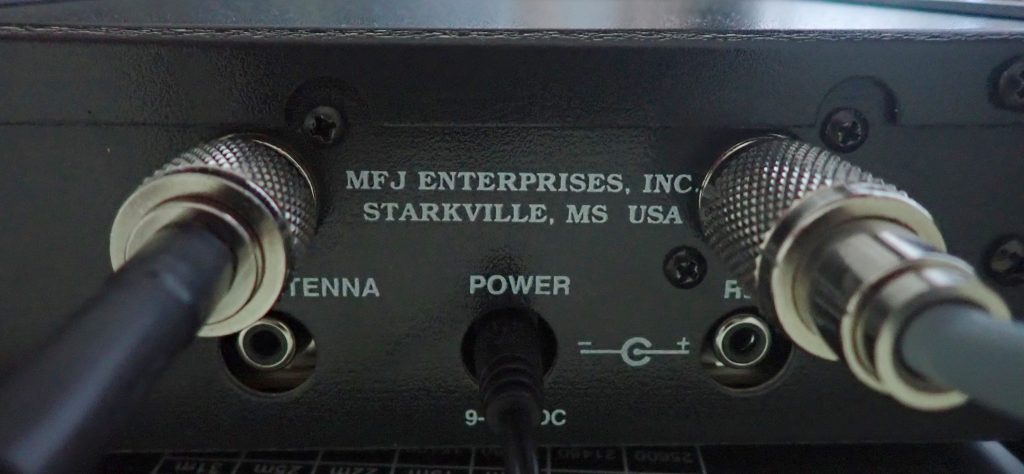
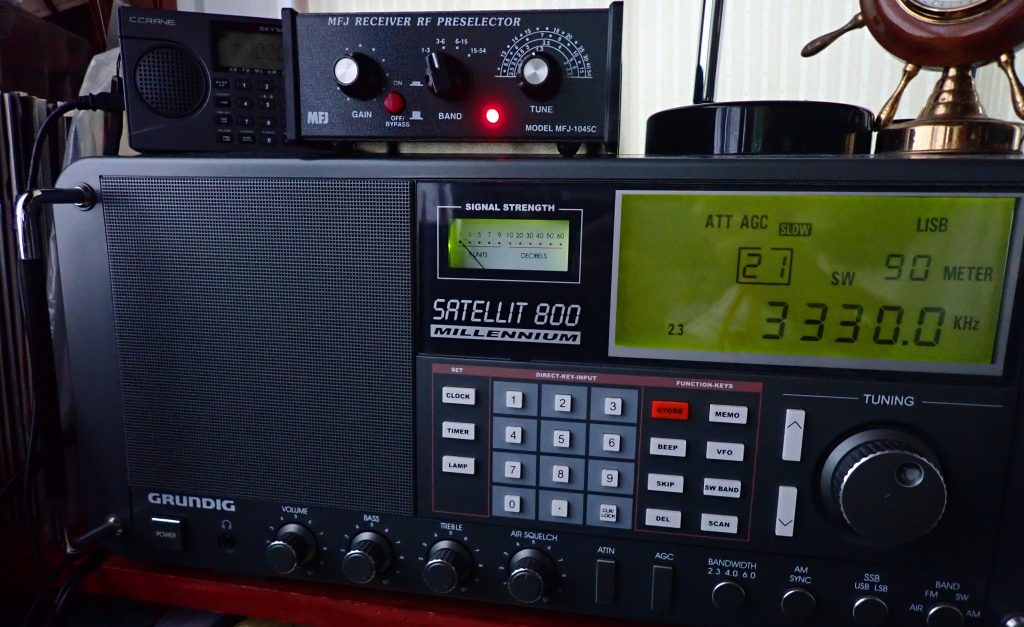
I would like to know if the MFJ-1046 works better than the MFJ-956.
Contact me … steve at vwebr dot net
I listen to between 3MHz and 10MHz usually with an active loop antenna.
I just bought a new to me Yaesu FRG-7700. I saw a picture of the receiver with a Yaesu antenna tuner and figure I should try a tuner. I read your article about the MFJ Preselector (MFJ-1045C) and was impressed. The unit was on sale at Ham Radio Outlet so I figure I would try it. I am very impressed with the performance. Not only did it eliminate some of the electrical power line noise but it really gave the signal a good boost! Thanks again for the review.
I enjoyed your article, Jock. When I was living an apartment about a decade and a half back, I used to drive to some nearby parks to do shortwave listening from my car to escape the EMI-riddled home environment. Sometimes I would string a wire antenna (Par Electronics End Fed for SWL) with the transformer connected to a mag mount that was on the roof of the car, with the coax leading to an Eton E1 inside the car. When stringing a wire wasn’t an option, I would just place a 12 foot MFJ telescoping whip (MFJ-1977) on the mag mount and run the coax through an MFJ-1045C to give a bit of a boost for frequencies under 15 MHz (the whip was ¼ wave around 18 MHz or so, so it performed pretty well with the ‘1045C bypassed for the upper end of the shortwave spectrum). The fact that the ‘1045C could be powered by a regular 9V battery was a convenience for this type of application. The gain control provided a nice range of amplification to suit need, while peaking with the preselector was straightforward and not did not require constant adjustment when scanning within a band.
I used MFJ’s ‘1046 preselector a number of times in the more distant past (MFJ probably should strike the word “new” from the product description). I remember the ‘1046 to require a lot of turning of the preselector tuning knob, especially when shifting from one band to another and, if I recall correctly, more adjustments to peak when tuning within a given band. I remember thinking that in order for one to accept that hassle of constant preselector adjusting, one must have to be listening in an very unusual RF environment or with a receiver with an unsually weak front end. Also, it would better suit a program listener who is parked a given frequency for a long period than someone who is constantly surfing the bands.
Jon,
Thanks for the kind words and your insight on the 1045C and 1046.
Cheers, Jock
Jock,good article,thanks To add to the kitty/confusion, MFJ has another magical black box that I used extensibly for a few years,the MFJ 959C .You can hook up 2 seperate antennas via two SO-239’s and also two seperate receivers also with SO-239 inputs on the back of the box.On the front of the box are push button switches to select which antenna and which receiver that you want to use.There is also an adjustable amp within the box,a by-pass (on/off button) plus three rotary knobs for fine tuning the black box to various length antennas and different receivers. So it is powered by a 12v 500 mA (mine) regulated wall wart from Jameco electronics (they still have them) There is also an attenuator button for strong signals.I have been useing that unit for about 10 years with many types of antennas at various lengths and it does a great job with any brand receiver.Happy Listening !
Jack,
Thanks for the kind words and info on the 959. Sounds like it meets your needs well and would be particularly useful for a listener with multiple antennas and/or receivers.
Cheers, Jock
Yes,I had about 100′ long wire ant and on the last 30′ I made a 90 degree turn on it.The second ant was a a 45′ dipole with 8 traps called the “Eavesdropper” from a place long gone “The Antenna Supermarket”So,I could use the E-1 XM or the Icom IC-R75 at will and compare signals and/or swap over to my two ant.choices.The long wire increased the signal strength at the cost of more noise,then the more quiet dipole,naturally.Pulling in Australia,New Zealand and Viernam was fun in the wee hours from the East Coast.once you got use to fine tuning the MFJ 959C it really helped in isolating a station from a lot of muck